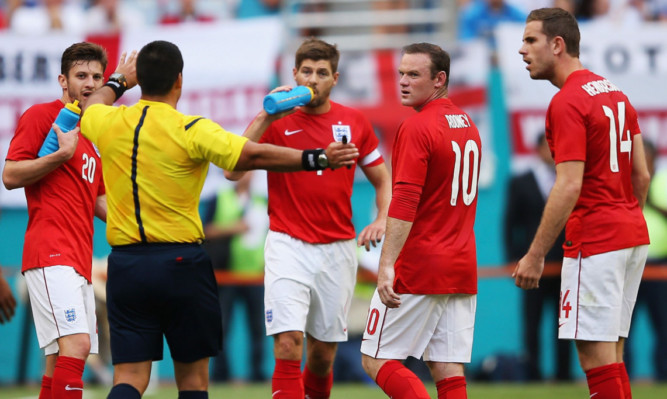
The World Cup might have been the football event of the year, but memories of Brazil have faded faster than the disappearing foam introduced to the Premier League in its wake.
The cans may make referees look like they’re wearing Batman’s utility belt, but they add clarity and have been a no-brainer.
But beyond the foam, what influence has the tournament had on the first half of the domestic campaign?
There certainly wasn’t a flood of big names arriving on the back of sensational individual displays in Brazil. Angel di Maria’s British record transfer to Manchester United was based more on his Real Madrid performances than those for his country, but the fact he had a decent tournament increased interest in how he’d do.
United did take his fellow Argentinean Marcos Rojo off the back of his excellent World Cup, and while Daley Blind was well known to Louis van Gaal, it was his intelligent performances for Holland that propelled him into the spotlight for the rest of us.
The other high-profile post-Brazil import was Alexis Sanchez at £35m, and there’s no question that he’s made an instant impact at Arsenal. Enner Valencia has done well for West Ham, Daryl Janmaat has been solid enough for Newcastle United. But beyond that, there has been little added to the overall quality of England’s top flight because of the World Cup.
In fact, it’s fair to say that two players who had pretty disastrous experiences in Brazil have been the most noteworthy recruitments.
Diego Costa looked a bit of a carthorse leading Spain’s line, and Cesc Fabregas barely kicked a ball. Chelsea would have run a mile from both had they based recruitment purely on that.
Jose Mourinho, however, had identified his requirements long before they flew to South America and they’ve been arguably the two most influential players in the Premier League so far.
There was always the possibility that the first few months would be skewed by World Cup injuries, fatigue and hangovers. Premier League stars played a combined total of more than 16 days of football during the summer. There were just 34 days between the World Cup Final and the Premier League’s opening weekend.
On the face of it, Mourinho had the most to worry about in terms of fatigue. Chelsea players featured for more time over 4,000 minutes and covered more ground than any other club’s squad.
Arsenal’s players spent the second most amount of time in on the field in Brazil, and had three players who went all the way to the trophy with Germany. Arsene Wenger delayed their start to give them extra rest, but Mesut Ozil quickly picked up a long-term injury, Lukas Podolski has rarely played and Per Mertesacker’s form has been erratic at best.
There’s certainly not been a knock-on effect in terms of carrying a feelgood factor into the club season.
Manchester United had 15 players in Brazil, and could claim to have had the most successful tournament on an individual level, managing nine goals between them. Robin van Persie was the highest-scoring English-based player but his long, hard summer looked to have impacted badly on his performance level until the last couple of weeks.
More serious for United was the fact that Louis van Gaal was involved with Holland until the middle of July and had to do months of tactical preparation in days, as well as overseeing a huge £150m transfer outlay. Given the chaos at Old Trafford over those weeks, the man whose performance as a coach in Brazil was perhaps the most eye-catching has done well to keep United in touch with the leaders.
Manchester City will argue that the summer did them no favours in terms of the wear and tear on key players Sergio Aguero and Vincent Kompany, both of whom continue to miss games because of muscular injuries.
Collectively, Liverpool’s players had a poor World Cup most of them were in the England squad, so no surprise there with only Luis Suarez shining briefly to heap misery his club-mates before doing his impersonation of Hannibal Lecter. No-one will ever know if a World Cup hangover is a factor in the club’s near collapse. It’s indisputable, though, that none of their English contingent Steven Gerrard, Jordan Henderson, Raheem Sterling, Glen Johnson, Rickie Lambert and Adam Lallana has been as impressive as they were last season.
If they’re the World Cup losers, Chelsea look the winners with City, United and Arsenal coming somewhere in between.

Enjoy the convenience of having The Sunday Post delivered as a digital ePaper straight to your smartphone, tablet or computer.
Subscribe for only £5.49 a month and enjoy all the benefits of the printed paper as a digital replica.
Subscribe